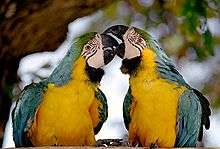Psittacidae
| Neotropical and Afrotropical parrots Temporal range: Eocene-Holocene | |
|---|---|
 | |
| Blue-and-gold macaws | |
| Scientific classification | |
| Kingdom: | Animalia |
| Phylum: | Chordata |
| Class: | Aves |
| Order: | Psittaciformes |
| Superfamily: | Psittacoidea |
| Family: | Psittacidae Illiger, 1811 |
| Subfamilies | |
The family Psittacidae is one of three families of true parrots, and consists of two subfamilies, the Old World or Afrotropical parrots of Psittacinae) and the New World or Neotropical parrots of Arinae.[1] The family numbers approximately 10 species in the Old World, and 148 species in the New World,[2] and included several species that have gone extinct in recent centuries. Some of the most iconic birds in the world are represented here, such as the blue-and-gold macaw among the New World parrots and the African grey parrot among the Old World parrots. These parrots are found in tropical and subtropical zones and inhabit Mexico, Central and South America, the Caribbean islands, sub-Saharan Africa and the island of Madagascar, and the Arabian Peninsula. Two parrots, one extinct, formerly inhabited North America.[3]
This family likely had its origin early in the Paleogene period (66-23 mya) after the western half of Gondwana had separated into the continents of Africa and South America, before the divergence of African and New World lineages c. 30-35 mya. It is estimated that the New World parrots (Arinae) and by implication Old World parrots, last shared a common ancestor with the Australian parrots (Cacatuidae) c. 59 mya.[4] The data place most of the diversification of psittaciforms around 40 mya, after the separation of Australia from West Antarctica and South America.[5][6] Divergence of Psittacidae from the ancestral parrots resulted from a common radiation event from what was then West Antarctica into South America then Africa via late Cretaceous land bridges that survived through the Paleogene.[7]
Taxonomy
The recently revised taxonomy of the family Psittacidae, based on molecular studies, recognizes the sister clade relationship of the Old World Psittacini and New World Arini tribes of subfamily Psittacinae,[8] which have been raised to subfamily ranking and renamed Psittacinae and Arinae. Subfamily Loriinae and the other tribes of subfamily Psittacinae are now placed in superfamily Psittacoidea of all true parrots which includes family Psittacidae.[9]
- subfamily Psittacinae
- genus Psittacus - African gray parrots (2 species)
- genus Poicephalus
- subfamily Arinae
- tribe Arini - macaws and parakeets
- tribe Androglossini - Amazon and related parrots
- clade (proposed tribe Amoropsittacini)
- clade (proposed tribe Forpini) - parrotlets
- genus Forpus
- (other tribes)
- genus Nannopsittaca
- genus Psilopsiagon
- genus Bolborhynchus
- genus Touit
- genus Pionites - caiques (4 species)
- genus Deroptyus - red-fan parrot
- genus Hapalopsittaca
- genus Brotogeris
- genus Myiopsitta - monk parakeet
References
- ↑ Leo Joseph, Alicia Toon, Erin E. Schirtzinger, Timothy F. Wright & Richard Schodde. (2012) A revised nomenclature and classification for family-group taxa of parrots (Psittaciformes). Zootaxa 3205: 26–40
- ↑ "Zoonomen: Zoological Nomenclature Resource".
- ↑ Forshaw, J. (2000). Parrots of the World, 3rd Ed. Australia: Lansdowne. pp. 303, 385.
- ↑ Tavares, Erika; Yamashita, Miyaki (Jan 2004). "Phylogenetic Relationships Among Some Neotropical Parrot Genera Based on Mitochondrial Sequences". The Auk. 121 (1): 230–242. doi:10.1642/0004-8038(2004)121[0230:prasnp]2.0.co;2.
- ↑ Schweizer, M.; Seehausen O; Hertwig ST (2011). "Macroevolutionary patterns in the diversification of parrots: effects of climate change, geological events and key innovations". Journal of Biogeography. 38: 2176–2194. doi:10.1111/j.1365-2699.2011.02555.x.
- ↑ Wright, et.al, T. (Oct 2008). "A Multilocus Molecular Phylogeny of the Parrots (Psittaciformes): Support for a Gondwanan Origin during the Cretaceous". Molecular Biology and Evolution. 25 (10): 2141–2156. doi:10.1093/molbev/msn160. PMC 2727385
 . PMID 18653733.
. PMID 18653733. - ↑ Remsen, Van. "Proposal (599) to South American Classification Committee: Revise classification of the Psittaciformes". Retrieved Oct 2013. Check date values in:
|access-date=(help) - ↑ Collar, N. (1997). Birds of the World, Vol.4. del Hoyo. p. 241.
- ↑ Joseph, et.al (2012). "A revised nomenclature and classification for family-group taxa of parrots (Psittaciformes)". Zootaxa (3205): 26–40.